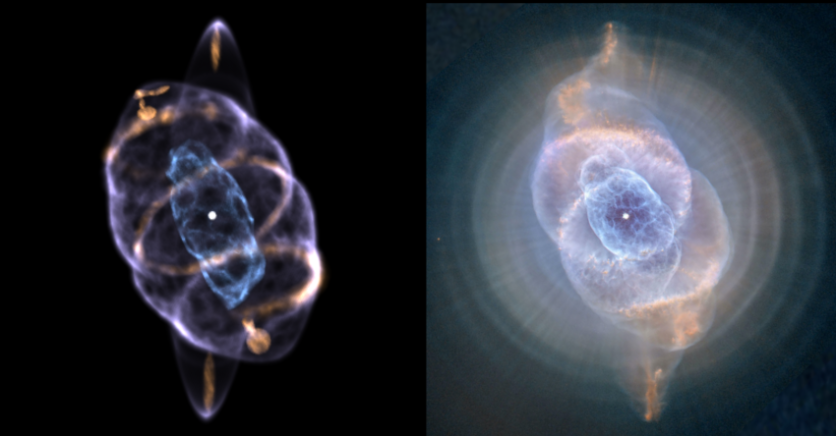A pair of symmetric rings are seen around the Cat's Eye Nebula's outer shell in the first computer-generated three-dimensional model of the nebula, developed by a team of astronomy researchers.
The symmetry of the rings, which suggests that a precessing jet formed them, provides strong evidence for the existence of a double star in the nebula's center, as per a press release from the Royal Astronomical Society. Ryan Clairmont, a fresh secondary school graduate, served as the study's principal investigator.

Binary Star in Cat's Eye
A planetary nebula, which is recognized by its brilliant, shell-like shape, is created when a dying solar-mass star expels its outer layer of gas.
The Cat's Eye Nebula, also known as NGC 6543, is one of the most intricate planetary nebulae out there. It is located in the constellation Draco and is a little over 3,000 light-years from Earth.
The Hubble Space Telescope has also captured high-resolution resolution images of the Cat's Eye Nebula, highlighting a complicated structure of knots, spherical shells, and arc-like filaments.
Astrophysicists were perplexed by the nebula's strange structure because it defied the predictions of established models for planetary nebula creation.
Precessing jets were identified in a more recent study as probable shaping mechanisms in intricate planetary nebulae like NGC 6543, but a thorough model was still lacking.
Clairmont, an enthusiast for astronomy, decided to determine the precise 3D structure of the Cat's Eye to learn more about the likely mechanism that gave it its unique appearance.
He enlisted the aid of Nico Koning from the University of Calgary and Dr. Wolfgang Steffen from The National Autonomous University of Mexico, both of whom created SHAPE. This 3D astrophysical modeling software is particularly suited for planetary nebulae.
The researchers used spectrum information from Mexico's San Pedro Martir National Observatory to rebuild the nebula's three-dimensional structure, which provided precise details on the internal motion of the nebula's material.
Unique 3D Model
Clairmont created a unique 3D model using these data and photos from the Hubble Space Telescope, suggesting that rings of high-density gas were encircling the Cat's Eye's outer shell.
They found out that the rings are nearly symmetrically, indicating that a jet, or a stream of high-density gas, expelled from the nebula's central star in opposite directions to form the rings.
The jet demonstrated precession, similar to a spinning top's wobbling motion. The jet wobbled, or precessed, and traced a circle, forming the Cat's Eye's rings.
The findings, however, show that the rings are only partial, proving that the precessing jet was only a transitory event and that it never completed a full 360-degree round.
An essential piece of data for the theory of planetary nebulae is the length of outflows. The team claimed that their findings are strong proof that a binary star system exists at the Cat's Eye's heart because only binary stars can drive a precessing jet in a planetary nebula.
Related Article : NASA's Hubble Space Telescope Captures 'Butterfly Nebula' In Stunning Motion | Fun Facts About This Beautiful Space Butterfly
This article is owned by Tech Times
Written by Joaquin Victor Tacla




